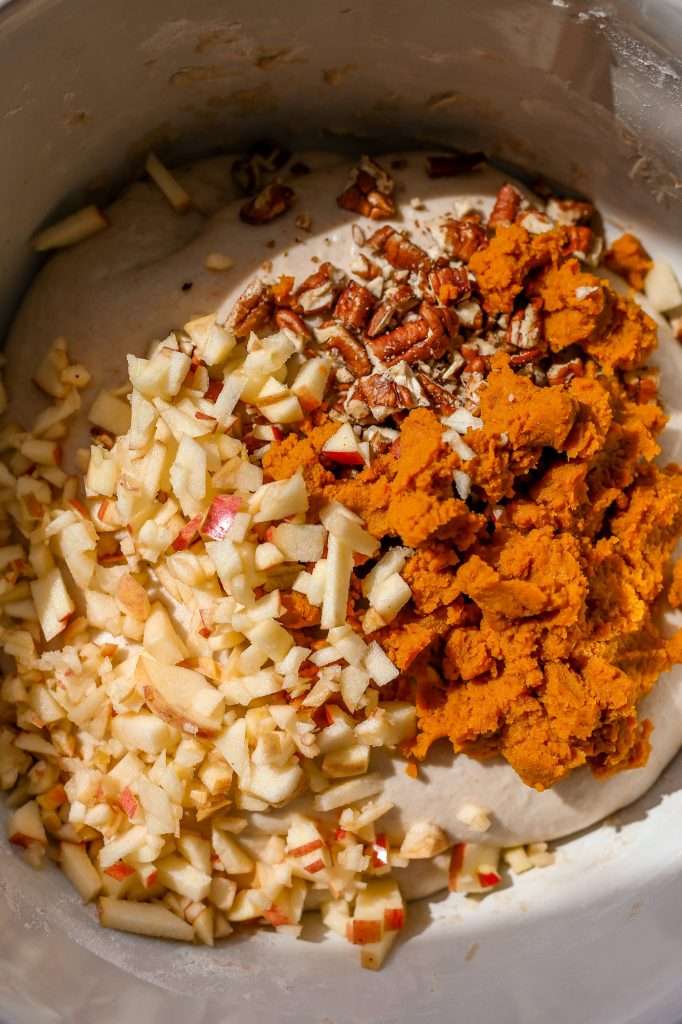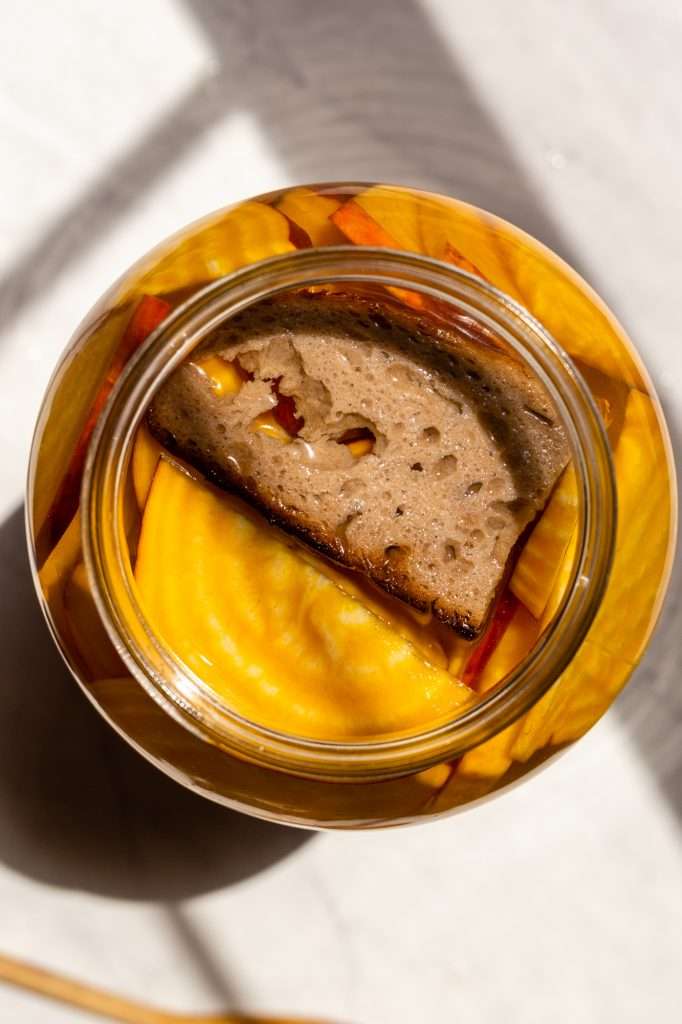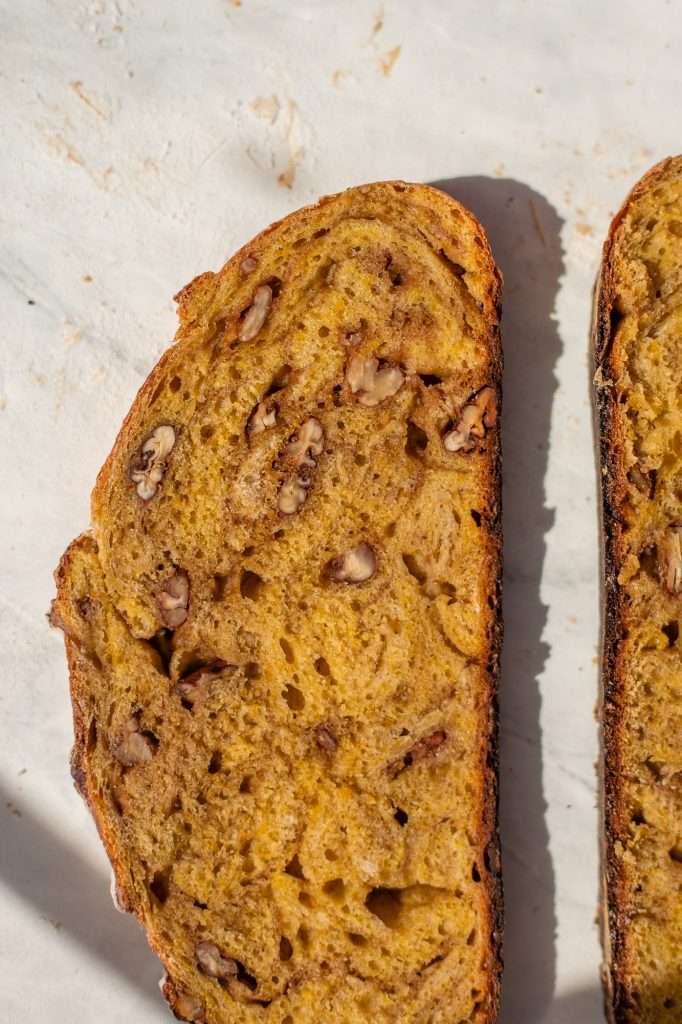Sourdough Pumpkin Apple Bread
Pumpkin apple bread is one of my favorite breads to bake every fall. When I see fresh apples and pumpkins at the local produce market, I know it’s time to start making this bread.
To make this bread, I strain pumpkin puree through butter muslin, separating the pumpkin juice from the pumpkin pulp. So, I always make a half gallon of my hard pumpkin cider the same day.
My hard pumpkin cider recipe calls for pumpkin juice strained from puree, so making these two recipes on the same day is the best way to use up all parts of the ingredients.

Making Pumpkin Apple Bread with Sourdough Starter
Here are some things you will need to make this delicious rustic pumpkin apple bread:
- Sourdough Starter: We have an easy sourdough starter recipe HERE. You’ll need to start this seven days before baking or two days before if you use our quick recipe option! I feed my starter 100% rye flour or a 50/50 all-purpose rye mix.
- Flour: I use bread flour or unbleached all-purpose for my Dutch oven sourdough boules.
- Water: You can use tap water to bake bread; I do. But if you prefer bottled or filtered, that works too!
- Salt: Unrefined sea salt, please! Just make sure your sea salt is unrefined and free from anticaking agents.
- Spray Bottle Filled with Fresh Water: This is a must-have for stretching and folding the dough.
- Dutch Oven: a 6-quart Dutch oven with a lid works best for this recipe. I have a Milo, and I love it.
- Proofing Basket: You can use a proofing basket like this one or a bowl with a tea towel coated in flour.
You’ll also fold some ingredients into the bread; here is what you need:
- Apple: one small, fresh apple will do. You can leave the peel on or peel it.
- Cinnamon: I like Ceylon cinnamon the best, but any ground cinnamon will work.
- Pecans: crushed pecans are the best, but walnuts or shelled pumpkin seeds can also be used.
- One 15-oz can of pumpkin puree: You’ll strain this through cheesecloth or butter muslin to separate the pulp from the juice. The pulp is what you use in the bread.

The Best Sourdough Pumpkin Bread with Apples
Since pumpkins are abundant in the fall, I’ve also used fresh pumpkins in this pumpkin apple bread recipe with great success.
If you want to use freshly roasted pumpkin in this recipe, you can! Here is how I roast fresh pumpkin to use in this bread:
Cut and clean a pumpkin, rub the inside with some oil, place it open-side down on a sheet pan, and roast at 425° F for about 20 minutes. Once completely cool, you can scoop the pumpkin out of the skin and use it in the recipe.

Tips on Making Sourdough Pumpkin Apple Bread
The hardest step to making this pumpkin apple sourdough bread is the stretching and folding. Incorporating the pumpkin, apple, pecans, and cinnamon takes patience and a gentle touch.

Tips for Stretching and Folding
- Don’t use a floured surface. You must turn the dough onto a clean surface to stretch and fold. Some people suggest sprinkling flour on the surface, but DO NOT. Get yourself a little spray bottle and fill it with fresh water. Spray your surface and hands with water before turning the dough out on the surface. This prevents sticking without making the dough dense with too much flour. The more hydrated your dough, the greater the rise will be.
- Make sure you adjust the time with the temperature. The time you need to wait between stretch and folds depends on the temperature in your house. If your house is above 75° F, you may be able to reduce the amount of time between stretch and folds to one hour.
- Do at least three wet surface stretches and folds in 6 hours. You can do a stretch and fold every hour for six stretches and folds or every two hours for three stretches and folds minimum.
- Add the apple, pumpkin, cinnamon, and pecans on the first stretch and fold. I wait until the first stretch and fold before incorporating the cinnamon and pecans. This helps the gluten build up before adding pecans that can tear the dough.
To add fillings to sourdough, wet your counter and gently stretch the dough out without breaking the dough.
Then, carefully spread half the filling over the dough before you roll it up and fold the sides over each other for the stretch and fold.
Then, you will knead the dough again. It will get sticky, and some ingredients may tear through the dough, but that’s okay.
Here is an excellent video from my favorite baker on YouTube, Bake with Jack, to help you learn how to incorporate fillings without breaking the dough. CLICK HERE.


The Benefits of Sourdough Bread with Apples, Pumpkin and Cinnamon
Sourdough bread is made out of flour, just like regular bread. However, the fermentation process makes the nutritional components of the flour more bioavailable.
Lactic acid bacteria in sourdough starters can reduce phytic acid, the compound that can prevent nutrient absorption in regular bread. Without the phytic acid binding to the minerals, you can absorb more potassium, phosphate, magnesium, folate, and zinc from the bread.
Since we use cinnamon, pumpkin, and pecans in this sourdough recipe, there’s even more variety of nutritional benefits. Pecans provide healthy fats and fiber; cinnamon is a natural anti-inflammatory spice.
Pumpkin is an underrated superfood; any winter squash, is a nutritional powerhouse. Rich in bioavailable vitamins A and C, pumpkin contributes to a robust immune system, promotes healthy skin, and supports eye health.
Pumpkins have a lot of dietary fiber, too, which aids in digestion and helps regulate blood sugar levels. Pumpkin contains antioxidants that protect against cellular damage, reducing the risk of chronic diseases such as heart disease and certain cancers.

More Sourdough Recipes to Try
- Sourdough Roasted Pumpkin Banana Muffins with Pecans
- Sourdough Fermented Gingerbread Cookies
- Dutch Oven Chicken Pot Pie with Sourdough Biscuits
- Sourdough Apple Pumpkin Cobbler with Cranberries

Sourdough Pumpkin Apple Bread with Cinnamon and Pecans
Want to warm up your house with the smells of fall and freshly baked bread? This rustic, fruity, and slightly sweet sourdough pumpkin apple bread is the best to bake this fall. The pumpkin, apple, cinnamon, and pecans combine for a fantastic flavor you’ll love.
- Prep: 20 minutes
- Cook: 1 hour
- Total Time: 7 hours 20 minutes
Ingredients
- 500 grams organic bread flour
- 300 grams water
- 100 grams sourdough starter
- 10 grams sea salt
- 40 grams maple syrup
- 3 Tablespoons pecans, crushed
- 30 grams pumpkin puree, strained*
- 1 small apple, fresh, minced
- 2 teaspoons cinnamon
Instructions
- It’s best to start the sourdough process before 9 am so you have enough time. Please check the notes section of this recipe for tips.
- In a large bowl, combine the starter, flour, maple syrup, and water.
- Knead the ingredients together until a uniform dough ball forms.
- Let the dough rest for 45 minutes.
- Wet your hands, and spray the dough with your water bottle. Sprinkle the salt over the dough, then knead it into the dough. Let rest for 30 more minutes.
- Using a spray bottle filled with water, mist your clean countertop. Wet your hands and wet the top of the dough ball with the spray bottle. Turn the dough out onto the wet counter surface. Scrape out the bowl and rinse the inside of the bowl really well. Leave the bowl wet.
- Stretch and fold the dough. Stretch the top of the dough over the bottom, side over side, and bottom over top.
- Place the dough back in the bowl with the seam side down. Let the dough rest for 30 minutes.
- Stretch and Fold 1 + adding the fillings: Using a spray bottle filled with water, mist your clean countertop again. Wet your hands and wet the top of the dough ball with the spray bottle. Turn the dough out onto the wet counter surface. Scrape out the bowl and rinse the inside of the bowl really well. Leave the bowl wet.
- Stretch out the dough into a rectangle, but be gentle and do not break or tear it. Sprinkle the cinnamon, apple, pumpkin pulp, and pecans over the dough. For a sweeter loaf, you can also sprinkle a bit of granulated sugar.
- Fold the ingredients into the dough; fold the top of the dough over the bottom, side over side, and bottom over top. Then you will knead the dough again, knead it until it is mostly smooth and the fillings are evenly distributed through the dough. It will get sticky and some pecans may tear through the dough, that’s okay. (Please watch the video linked in the blog post above if you need more guidance).
- Repeat another stretch and fold then place the dough back in the bowl with the seam side down. Let the dough rest for 1 to 2 hours.
- Stretch and Fold 2: Using a spray bottle filled with water, mist your clean countertop again. Wet your hands and wet the top of the dough ball with the spray bottle. Turn the dough out onto the wet counter surface. Scrape out the bowl and rinse the inside of the bowl really well. Leave the bowl wet.
- Stretch and fold the dough. Stretch the top of the dough over the bottom, side over side, and bottom over top. Place the dough back in the bowl with the seam side down. Let the dough rest for 2 hours.
- Stretch and Fold 3: Using a spray bottle filled with water, mist your clean countertop again. Wet your hands and wet the top of the dough ball with the spray bottle. Turn the dough out onto the wet counter surface. Scrape out the bowl and rinse the inside of the bowl really well. Leave the bowl wet.
- Stretch and fold the dough. Stretch the top of the dough over the bottom, side over side, and bottom over top. Place the dough back in the bowl with the seam side down. Let the dough rest for 1 to 2 hours.
- Clean and dry the counter surface you’re working on. Sprinkle some flour on the surface of your counter and coat your hands in a bit of flour. Gently flip the dough out onto the floured surface so that it is seam side up.
- Pre-shape: Gently stretch out the dough, and fold it again. Fold side over side and top over bottom. Then flip the dough over so that the seam side is down on the counter. Tuck under any parts of the dough you need to form a nice circular shape. Leave the dough on the counter, sprinkle some flour on the top of the dough, and cover with a tea towel.
- Let the dough rest for 1 hour.
- Sprinkle a little more flour on the top of your pre-shaped dough and on the counter around the dough. With your hands coated in flour, flip the dough over so that the seam side is up again.
- Gently stretch out the dough, and fold it again. Fold side over side and top over bottom. Then flip the dough over so that the seam side is down on the counter. Tuck under any parts of the dough you need to form a nice circular loaf shape. This is the final shaping so take your time with it.
- Coat a proofing basket with flour. Be generous, as you do not want it to stick. You can also use a bowl lined with a towel and a generous amount of flour.
- Flour your hands and swiftly pick up and flip your dough into the basket. Smooth side down, seam side up.
- Cover and place in the fridge overnight for 8-12 hours.
- After 8-12 hours in the fridge, preheat your dutch oven with the lid, in your oven at 450° F. (see notes on temperature)
- Once your oven is preheated, carefully remove your dutch oven and place the lid to the side. *Don’t forget that the pot and the lid are both very hot!*
- Cut a large square of parchment paper and place it on the counter. Turn your dough out onto the paper so that the seam side is down and touching the parchment paper.
- Score the dough using a very sharp knife or a scoring tool.
- Picking up all four corners of the parchment paper, move your dough into the dutch oven.
- Place the lid on the dutch oven and bake at 450 F for 35 minutes.
- After baking covered, remove the lid and bake for another 20-30 minutes at 450 F.
- Remove your finished loaf from the dutch oven and allow it to cool for at least 1 hour.
Notes
- To strain the pumpkin puree: Open a 15-ounce can of pumpkin puree. Place a colander in a large bowl and line the colander with a few layers of cheesecloth or butter muslin. Dump the puree in the lined colander and allow the pumpkin juice to separate from the pulp, collecting the juice in the bowl. Use the pulp in this recipe.
- Alternative to canned pumpkin: Cut and clean a pumpkin, rub the inside with some oil, place it open-side down on a sheet pan, and roast at 425° F for about 20 minutes. Once completely cool, you can scoop the pumpkin out of the skin and use it in this recipe.
- The time you need to wait in between stretch and folds depends on the temperature in your house. If your house is above 75° F, you may be able to reduce the amount of time between stretch and folds to one hour.
- You can also speed up the time in between stretch and folds by using a bread proofer or heating pad near the dough. Just stretch and fold when the dough has risen a bit and relaxes out into the bottom of the bowl, and make sure you do at least three stretches and folds. Monitor the dough to make sure you do not over-proof.
- when flouring your proofing basket, it helps to use coarse flour such as rye, masa, or rice flour.
- Depending on your oven, you can bake at a lower temperature. Some ovens run hotter than others.
- When baking with the dutch oven lid off, check every few minutes. Some ovens run hotter than others, so check to see when the loaf is golden brown.





















I made these as is but with salted butter and chocolate chips and they were delicious. 10 out of 10.
Delicious! This bread was flavorful and moist. We ate it fresh and toasted it.
Are the long times between stretch and folds considered the bulk fermentation?
yep!
Wow, a lot of work but the best loaf of sourdough I have ever made! So soft and fluffy with a not too thick of a crust!
yay! Thanks for leaving a review!
Just came out of the oven and it’s beautiful. Can’t wait to eat it.
Best fall recipe! Very wholesome to bake.
Hello,
Can this be made into an artisan bread, as sourdough isn’t something I have mastered yet?
Thanks
Charna
As in using some packaged yeast? totally! You’ll just adjust the rise times